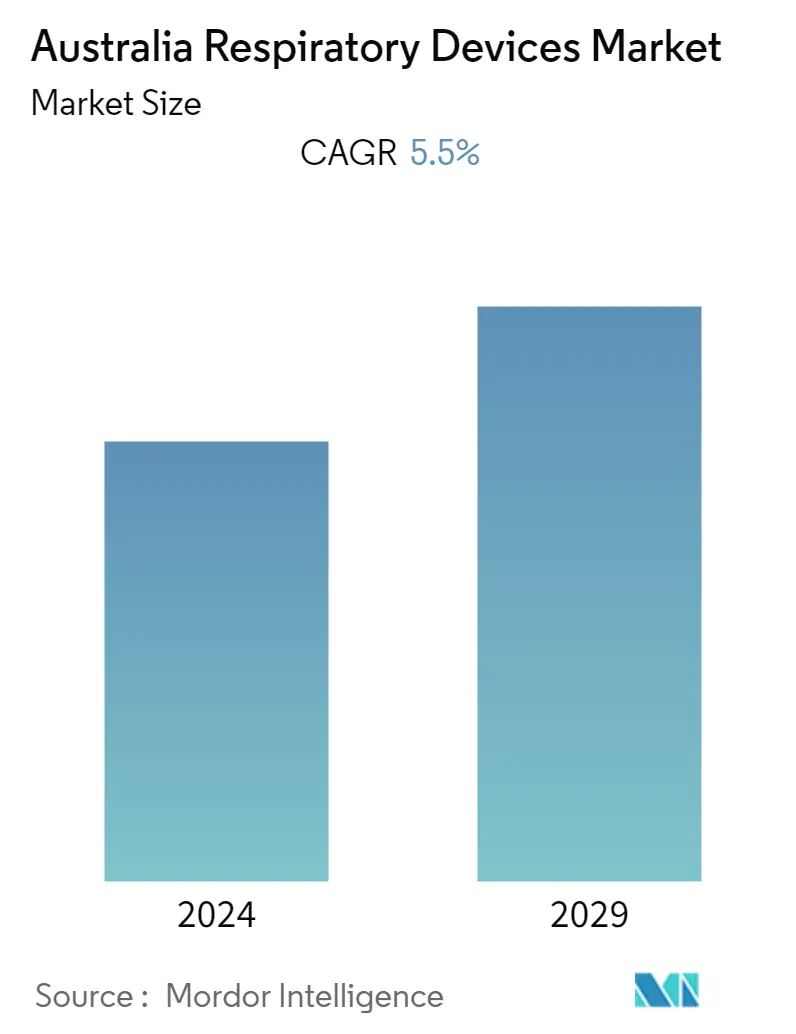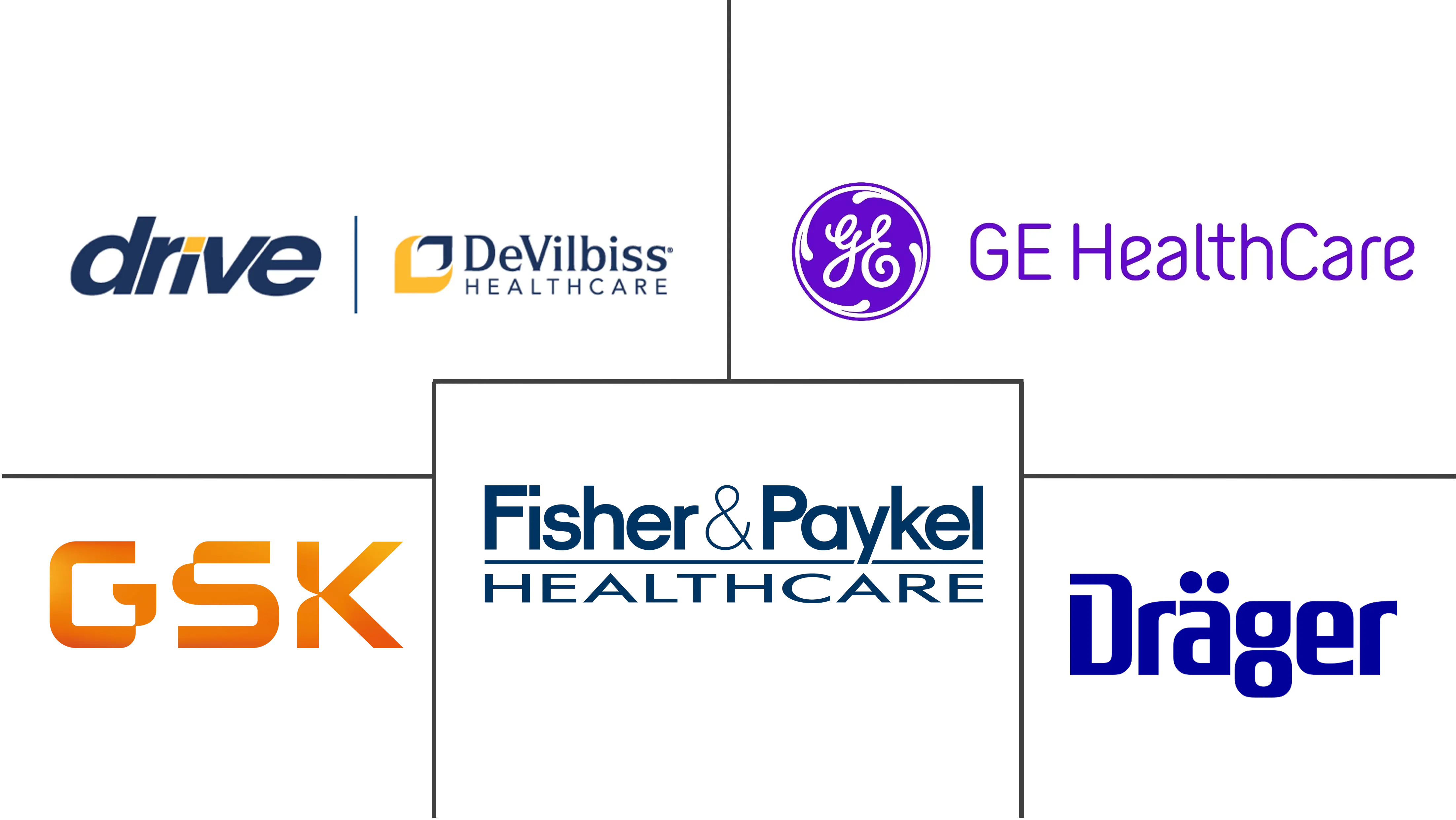Market Size of Australia Respiratory Devices Industry

| Study Period | 2019 - 2029 |
| Base Year For Estimation | 2023 |
| Forecast Data Period | 2024 - 2029 |
| Historical Data Period | 2019 - 2022 |
| CAGR | 5.50 % |
| Market Concentration | Low |
Major Players
*Disclaimer: Major Players sorted in no particular order |
Australia Respiratory Devices Market Analysis
The Australian respiratory devices market is expected to register a CAGR of 5.5% over the forecast period.
- The COVID-19 pandemic had an exponential impact on the respiratory devices market during the pandemic. The demand for ventilators, oxygen concentrators, and other respiratory devices was significantly higher in the country during the pandemic. For instance, as per the data published by the Australian Institute of Health and Welfare, in July 2022, the government spent USD 7.7 billion (4 billion by the Australian Government and USD 3.7 billion by state and territory governments) through the National Partnership on COVID-19 Response (NPCR). Additionally, as per the same source, the government invested USD 13.6 million to provide access to pulse oximeters and extended distribution arrangements for PPE from the NMS to general practice and other healthcare settings to support the safe management of COVID-19-positive people. Hence, owing to the above-mentioned factors, COVID-19 had a significant impact on the studied market. However, with the COVID-19 cases in control, the market seized slightly in the current scenario as compared to the pandemic in terms of demand for respiratory devices. Furthermore, due to the increasing prevalence of respiratory disorders and technological advancements in devices, the market is expected to witness significant growth over the forecast period.
- The high prevalence of respiratory diseases such as chronic obstructive pulmonary disease (COPD), asthma, and pneumonia in the country is expected to propel the market growth during the forecast period. For instance, according to the Australian Bureau of Statistics, March 2022 update, 375.8 thousand individuals (1.5%) of all ages had COPD in 2021. The same source stated that roughly 2.7 million (10.7%) Australians were suffering from asthma in 2021. Moreover, the prevalence of asthma was higher in females (12%) as compared to males (9.4%). Therefore, the high burden of COPD and asthma in the country is projected to boost the demand for respiratory devices such as oximeters, inhalers, nebulizers, and oxygen concentrators for the management of such diseases, which is further expected to augment the market growth.
- In addition, the rising government funding to develop and accelerate the production of essential respiratory devices in the country is also contributing to market growth. For instance, in March 2022, the Australian government invested USD 248.1 million to extend the operational timeframe for the general practice-led respiratory clinics (GPRC) Program and network of up to 150 GPRCs across Australia until 30 September 2022. Thus, such investments and government initiatives are anticipated to accelerate the demand for advanced respiratory devices in the newly established respiratory clinics, hence propelling market growth.
- Furthermore, the technological advancements by market players in respiratory devices significantly contribute to the market growth. For instance, in May 2021, HeiQ Materials AG utilized anti-viral textile technology developed by Australian materials technology company Xefco Pty Ltd with support from Deakin's Institute for Frontier Materials (IFM) to produce medical-grade face masks. The masks will incorporate new patent-pending technology, called MetalliX, invented by Xefco and further tested and refined with help from IFM researchers. Such research-driven developments are expected to boost the demand for respiratory disposables, thereby propelling the market growth.
- Therefore, owing to factors such as the high burden of respiratory diseases such as COPD and asthma and rising government investment for the expansions of respiratory clinics, ultimately boosting the demand for respiratory devices along with product launches, the studied market is anticipated to witness growth over the analysis period. However, the high cost of devices is expected to restrain the market growth.
Australia Respiratory Devices Industry Segmentation
Respiratory devices include respiratory diagnostic devices, therapeutic devices, and breathing devices for administering long-term artificial respiration. It may also include a breathing apparatus used for resuscitation by forcing oxygen into the lungs of a person who has undergone asphyxia.
The Australian respiratory devices market is segmented by type (diagnostic and monitoring devices (spirometers, sleep test devices, peak flow meters, pulse oximeters, capnographs, and other diagnostic and monitoring devices), therapeutic devices (CPAP devices, BiPAP devices, humidifiers, nebulizers, oxygen concentrators, ventilators, inhalers, and other therapeutic devices), and disposables (masks, breathing circuits, and other disposables).
The report offers the value (in USD) for the above segments.
| By Type | ||||||||||
| ||||||||||
| ||||||||||
|
Australia Respiratory Devices Market Size Summary
The Australian respiratory devices market is poised for growth, driven by the increasing prevalence of respiratory disorders such as chronic obstructive pulmonary disease (COPD) and asthma, alongside technological advancements in medical devices. The market experienced a significant surge during the COVID-19 pandemic due to heightened demand for ventilators and oxygen concentrators, supported by substantial government investments. Although the demand has stabilized post-pandemic, the market continues to expand due to ongoing government funding and the establishment of respiratory clinics. These initiatives are expected to enhance the availability and adoption of advanced respiratory devices, thereby propelling market growth over the forecast period.
The market is characterized by moderate competition, with numerous global players actively engaging in strategic initiatives like product launches, mergers, and partnerships to strengthen their market presence. The introduction of innovative devices, such as Getinge's Servo-c mechanical ventilator and Vyaire Medical's AioCare mobile spirometry system, underscores the industry's focus on technological advancement. Additionally, government efforts to donate ventilators and support international health initiatives highlight the country's robust production capabilities. Despite the high cost of devices posing a potential challenge, the market is anticipated to grow, driven by the demand for effective management of respiratory conditions and the continuous development of cutting-edge medical technologies.
Australia Respiratory Devices Market Size - Table of Contents
-
1. MARKET DYNAMICS
-
1.1 Market Overview
-
1.2 Market Drivers
-
1.2.1 Increasing Prevalence of Respiratory Disorders
-
1.2.2 Technological Advancements in Devices
-
-
1.3 Market Restraints
-
1.3.1 High Cost of Devices
-
-
1.4 Porter's Five Forces Analysis
-
1.4.1 Threat of New Entrants
-
1.4.2 Bargaining Power of Buyers/Consumers
-
1.4.3 Bargaining Power of Suppliers
-
1.4.4 Threat of Substitute Products
-
1.4.5 Intensity of Competitive Rivalry
-
-
-
2. MARKET SEGMENTATION (Market Size by Value - USD)
-
2.1 By Type
-
2.1.1 Diagnostic and Monitoring Devices
-
2.1.1.1 Spirometers
-
2.1.1.2 Sleep Test Devices
-
2.1.1.3 Peak Flow Meters
-
2.1.1.4 Pulse Oximeters
-
2.1.1.5 Capnographs
-
2.1.1.6 Other Diagnostic and Monitoring Devices
-
-
2.1.2 Therapeutic Devices
-
2.1.2.1 CPAP Devices
-
2.1.2.2 BiPAP Devices
-
2.1.2.3 Humidifiers
-
2.1.2.4 Nebulizers
-
2.1.2.5 Oxygen Concentrators
-
2.1.2.6 Ventilators
-
2.1.2.7 Inhalers
-
2.1.2.8 Other Therapeutic Devices
-
-
2.1.3 Disposables
-
2.1.3.1 Masks
-
2.1.3.2 Breathing Circuits
-
2.1.3.3 Other Disposables
-
-
-
Australia Respiratory Devices Market Size FAQs
What is the current Australia Respiratory Devices Market size?
The Australia Respiratory Devices Market is projected to register a CAGR of 5.5% during the forecast period (2024-2029)
Who are the key players in Australia Respiratory Devices Market?
GSK PLC, GE Healthcare Inc., Drive Medical (DeVilbiss Healthcare LLC), Drägerwerk AG & Co. KGaA and Fisher & Paykel Healthcare Ltd are the major companies operating in the Australia Respiratory Devices Market.

